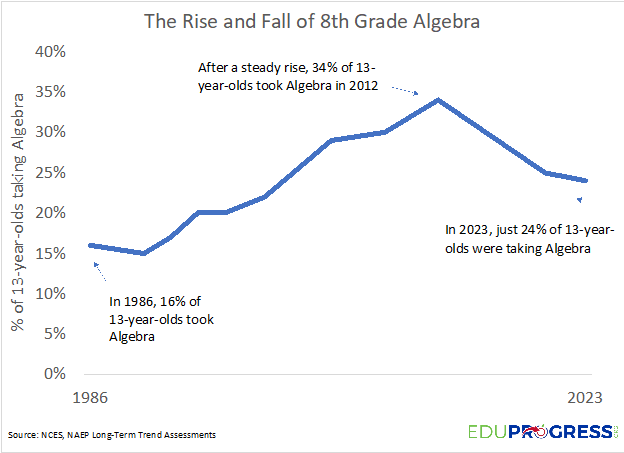Algebra is a gateway toward more advanced mathematics courses, and passing the course in 8th grade is a strong predictor of future college success. All students can be math solvers, but students need opportunities to prove it.
Unfortunately, schools have been limiting opportunities for students to take Algebra in 8th grade, and it shows up in a remarkable graph of the national data.
In 1986, for example, 16% of American 13-year-olds were taking Algebra. After two decades of steady gains, that figure hit an all-time high of 34% in 2012.
But then it started to fall. By the 2022-23 school year, the percentage of 13-year-olds enrolled in Algebra had fallen back to 24%.

Was this just an instance of schools re-labeling what “Algebra” meant? That’s possible, but the evidence suggests that wasn’t the main culprit. Math achievement scores across the country followed a similar trend, rising for most of the 1990s and early 2000s before peaking around 2012 or 2013.
This is also not a COVID story. Although the pandemic certainly did not help the situation, much of the decline took place well before COVID.
Of course, not all students are ready to take Algebra in 8th grade, and it’s important for state and district leaders to be thoughtful about who is ready to benefit from it. California, for example, provides a cautionary tale. When California tried an “Algebra for All” policy, students who enrolled in 8th-grade algebra increased their enrollment in advanced math classes in 9th grade by 30 percentage points and 11th grade by 16 percentage points. Women, students of color, and English-language learners all saw the largest benefits.
And yet, that same research also found that districts that set the bar for Algebra too low—and let in too many underqualified candidates—ended up setting those students back.
The trick, then, is to open doors of opportunity for students who are ready to succeed while giving other students more time to get there. And there’s a nifty solution to that: Automatic enrollment policies that use state test scores to identify students who are ready. As Dale Chu and I wrote last year, states like North Carolina, Texas, and Washington have all adopted versions of this idea. Thanks to their simplicity and fairness, these automatic enrollment policies won the inaugural March Mathness tournament earlier this spring.
As a country, we’re currently living through an era of limiting options and decreasing rigor for students. That’s not a good direction and, to get back on track, schools and districts will need to find ways to identify students who are ready for Algebra in 8th grade and then give those students pathways to succeed.

